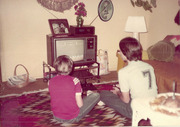tv American History TV CSPAN May 9, 2015 5:49pm-6:01pm EDT
5:49 pm
a young boy. the signs of it where there, and the turmoil of that world and the quest for revenge that the average german had at the time -- i just knew that it would come to another war in which i no doubt would be involved -- the signs were there. >> with life coverage of the u.s. house on c-span and senate coverage on c-span2, we complement that covers by showing you the most relevant congressional hearings. on weekends, c-span3 is home to american history tv including six unique series, the civil war's 150th anniversary visiting battlefields and key events american artifacts, touring museums and historic sites to discover what artifacts reveal about america's past. "history books up" with the best-known american history writers, the presidency looking at policies and legacies of our nation's commanders in chief, lectures and history with top college professors delving into america's past, and our new series "reel america,"
5:50 pm
featuring archival government and educational films. c-span3, created by the cable industry and funded by your local cable or satellite provider. watch us on tv, like us on facebook and follow us on twitter. >> this year c-span is touring cities across the country exploring american history. next, a look at our recent visit to topeka, kansas. you are watching american history tv all weekend every weekend on c-span3. ♪ >> we are standing in the
5:51 pm
kindergarten room of the munro elementary school at roundtree board of education -- brown versus board of education historic site. this was of the four african-american elementary schools that was operating in topeka in 1951 when the brown versus board of education was filed. it was a small peas of a larger piece that started back in the late 1920's and early 1930's, which is part of the national association for the advancement of colored people's or the naacp's struggle to over term -- overturn segregation. that would lead to overturning a case, a supreme court decision that allowed the state of louisiana to segregate railcars by race.
5:52 pm
once the supreme court made the decision that was constitutional, you saw an explosion of laws in the south especially that permitted segregated facilities in all sectors of public life. they were attended to overturn a precedent and they knew they could try to do it in one case but if they lost, it would be the end of their attempt. really beginning in the 1930's, they began to file cases to chip away at the precedent. the strategy was to end segregation in law school and graduate school and then worked down to college and then worked down to elementary schools. brown versus board of education, the name is the first to appear out of the list of plaintiffs. the local chapter of an aa cp, the lawyers recruited 13 of those parents had children who attended, one of them being the
5:53 pm
monroe school we're we are now -- where we are now. a man, the lawyers basically recruited people they knew or thought would be good, upstanding participants. all of her brown was really just one of those 13 volunteers -- oliver brown. as historians have noted, it is often accidental whose name gets attributed. oliver brown's name is listed first even though there was another woman on the list of plaintiffs who would have been first alphabetically. for some reason, oliver brown's name was listed first. he was simply one of those 13 parents recruited nationwide there were five cases that were part of the brown decision which included 200 planes total. buy a chance of history, we refer to the brown family when they were one piece of a larger story per the kindergarten room
5:54 pm
tells an important piece of the story. the facilities here were excellent peer to what a lot of people walked in, if they're old enough to remember going to kindergarten in a school like this, it looks just like the one they attended whether they were white or black. the facilities were excellent. the kindergarten room serves to remind people education is about being in a safe place where you can learn from people who are sympathetic to you and understand you and that was exactly what happened here in the elementary school and this was an excellent experience and when they go out and see the exhibits and see the photographs of what schools were like in south carolina and virginia and the district of columbia, and we see the afton american communities and what they adore, we begin the question then of how difficult it was for african-americans all across the country to receive a good education in their community. here in topeka, if you look at
5:55 pm
the school's just standing outside, you would be hard-pressed to determine whether white students or african students attended because the school board really provided all of the same material to light school offered. what is more interesting for most people when they come to visit his they find out after graduating from elementary school, african-american students attended integrated high schools because the law and kansas only permitted segregation and elementary schools with cities of more than 15,000 people. you had separate schools in topeka and a dozen others in the early 1950's, but no others in kansas could legally segregate their elementary schools. while there were no supporters of segregation and they saw the injustices, the african-american community also was very proud of their schools. these were excellent facilities.
5:56 pm
teachers teaching in the classroom like the one we are standing in right now all had bachelors degrees if not masters degrees. these were some of the only professional jobs for african-american women in the city of topeka. that was going to be lost once the schools were integrated in while there was support for the idea of integration, there was also resistance, especially from the teachers and the local chapter who feared the loss of these institutions and the loss of those jobs. that was not unwarranted. when the middle school integrated a few years before, thereafter american teachers who lost their job. there was a tension between what would be gained, full access to neighborhood schools, where it is african-american children lived, but also a sense of loss of what would happen to these teachers in these institutions. the museum was very much designed to tell the broader story of the struggle for civil rights and american history.
5:57 pm
the roots go back to slavery in the united states. you will be greeted by a park ranger and the focal or the -- or beginning point was a 25 minute series of films, set up as a dialogue between a young woman an older man, which basically traces the struggle of civil rights. the origins of slavery, the abolition of slavery and the civil war, and its replacement which was every bit as unjust, which was jim crow laws. that visitors can move into the first gallery of exhibits which will set the importance of education in after american community and that leads up to the decision to use education as the legal issue whereby the naacp would end all segregate -- segregation laws. that was really just the wedge issue to integrate educational facilities and then all of the other dominoes of segregation institutions would fall.
5:58 pm
they did not fall easily pair one of the most powerful portions of the exhibit was the hall of courage, news footage gathered from around the country, in opposition from the decision and the movement and that took place all over the nation, including where there were riots. there were not any major disruptions here in topeka and kansas but there was on a national level, extremely costly to the united states. to imagine what it must be like to he a 16-year-old boy or girl or be -- and be confronted by the mob is what the hall of courage attempted to create. it is probably one of the most visceral and most powerful parts here. one of the things we are here to do is help engage in dialogue about these kinds of issues.
5:59 pm
they are ongoing and continuous in our society and there are new groups constantly struggling for better and equal access to civil rights. the mission to preserve our country's's heritage, we do not go and build museums about subjects that are important. we reserve voices -- places that were an integral part of that story. by preserving the pieces of heritage, even if there are difficult stories to tell, like immigration, or japanese internment camps, that visitors, whether abroad or caucasian or ask an american, you better understand the story when you are standing in the place where the events happen. there is something intangible about these places reconnection feel the history resonating.
6:00 pm
>> find out where c-span's city tour is going next. you are watching "american history" tv all weekend, every weekend. >> historian daryl scott talks about the evolution of how after negative americans -- how african-americans view the civil war. he describes generational differences and how it impacted how african-americans think of the war and its legacy. this hour-long program took place at the old naval hospital hill center in washington, d.c. >> i would like to welcome you again for the opening day celebration. this evening we have two wonderful scholars to engage us on a discussion about the civil war. serving as the moderator this evening is yoni appelbaum.
69 Views
IN COLLECTIONS
CSPAN3 Television Archive
Television Archive  Television Archive News Search Service
Television Archive News Search Service 
Uploaded by TV Archive on

 Live Music Archive
Live Music Archive Librivox Free Audio
Librivox Free Audio Metropolitan Museum
Metropolitan Museum Cleveland Museum of Art
Cleveland Museum of Art Internet Arcade
Internet Arcade Console Living Room
Console Living Room Open Library
Open Library American Libraries
American Libraries TV News
TV News Understanding 9/11
Understanding 9/11










